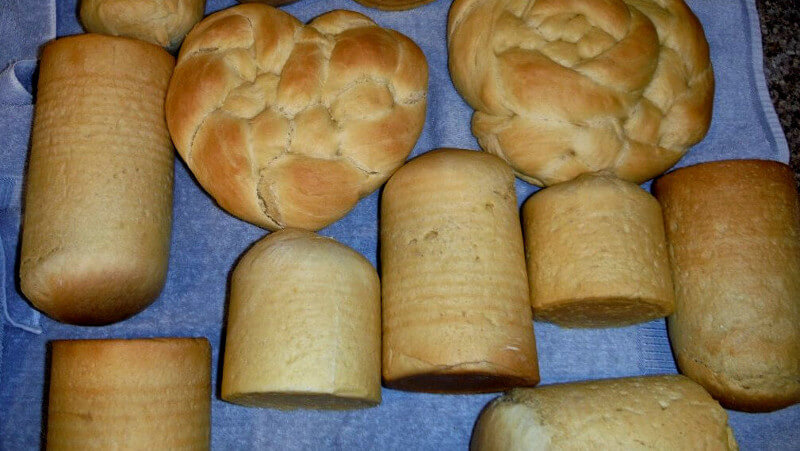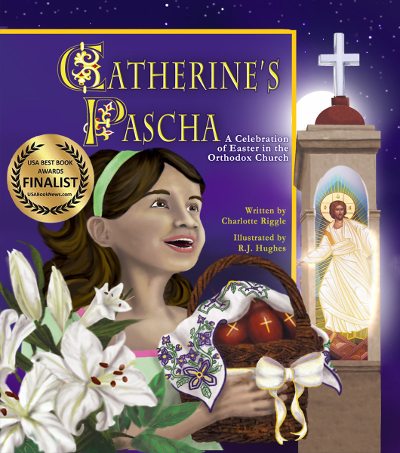Paska, or pascha, is a sweet spread made with cheese and eggs. You eat it with kulich, which is a sweet, rich Easter bread. Depending on where you’re from, kulich might also be called paska, and paska (the cheese kind) might go by other names as well. Whatever they’re called, they’re a treat to eat from Pascha until Pentecost.
My friend Natalie learned how to make pascha and kulich in her family when she was growing up. Here are her recipes.
Natalie’s version of Anna Kolesnikov’s Kulich
makes 6 tall kulich
This is a variation of my mother Anna’s recipe, whose Russian roots come from the Cossacks of the Caucasus mountains in Russia. She kneaded double this recipe by hand in the largest bowl you can imagine. I halved the recipe and use a large stand mixer. We raise chickens on our land and have learned that food tastes richer if you use eggs and dairy from animals raised on pasture. Not only is the nutrition higher, but the colors are a deeper yellow, too. Fine ingredients will produce prettier and tastier dough, so use the best you can find.
Mix in the large bowl:
10 raw egg yolks and 2 raw whole eggs (organic, pastured eggs for a beautiful golden dough)
1 ½ cups cane sugar
Add:
1 tsp. each of real Vanilla and Almond extract
1 Tbs. of vodka that had had saffron soaked in it overnight (or all year in the fridge)
1/8 tsp. cardamom powder
1/8 tsp. nutmeg powder
Warm up 2 cups of whole milk but only so hot that you can hold your finger in the pot
Mix with a fork and let rise double:
1 ½ cups of the warm milk
2 pkts of Red Star dry active yeast
3 Tbs. of flour
3 Tbs. of sugar
With last ½ cup of milk, melt:
8 oz. (ie, 1/2 lb or 2 sticks) Organic Valley pastured butter
8 oz. package of Organic Valley cream cheese
After ingredients cool, combine all ingredients together into the large bowl, stirring with a wooden or plastic spoon (not metal, which turns dough colors) and adding flour until you can knead it by hand. Use unbleached flour. I use Bob’s Red Mill organic flour and/or Jovial einkorn flour. I buy a new 5 lb bag of flour and use about ¾ of the bag.
Let rise 1 hour in a warm (100 degrees and turned off) dark oven, covered with plastic wrap and towel.
While the dough rises, trace empty pineapple juice cans and cut out circles of parchment paper. I use unbleached “If You Care” parchment paper that is already coated, otherwise you may need to butter your paper. Also line the sides of the cans with a sheet of parchment paper. The wide, short cans that hold 28 oz. of organic diced tomatoes are coated inside with a BPA-free copper that washes and stores well to keep for next year’s Pascha. If you extend the parchment paper well above the lip, the dough will continue to grow tall without spilling out over the can. You can let the dough sit in the cans for a half hour or so until they fill the width of the cans prettily.
Preheat the oven to 275 degrees.
After the dough rises, my mother likes to knead in golden raisins that have been soaked/rehydrated in rum, but I prefer adding only slivered almonds I get from Trader Joe’s. Sometimes I don’t add anything at all.
Pinch off and drop a blob of dough into each can, filling the cans halfway.
Let the cans rise double, until the dough almost fills the cans.
If you want to make giant coffe-can kulich, cover the top with tin foil, so that it doesn’t burn.
Bake on 275 for 60 minutes or until the tops of the kulich start turning golden brown.
Take the kulich out of the cans immediately. Slide the kulich out of the cans sideways by pulling on the parchment paper. Remove paper and lay the kulich on its side on a towel. Cover the kulich with another towel to keep them moist as they cool. Roll them every few minutes, so that they keep their round shape as they cool.
I prefer to keep the tops of my kulich plain, but you can drizzle the tops with a white frosting and decorate with sprinkles or red hots and silver candies. “X.B.” (the acronym for the Russian Paschal greeting) is a traditional design to write on top, but keep the center clear for your candle.
Here are two variations of the white frosting tops:
Drizzle top with a mixture of ½ cup organic powdered sugar, ½ tsp. lemon juice, and 1 tsp. warm water. Keep the consistency thick, as it will drip for a while.
If you have access to farm fresh eggs that you trust, you can make this meringue version, but it needs a few days to dry before Pascha, so plan accordingly. Open the bags in which you stored the kulich and fold down the edges, perhaps securing them with a rubber band, so that the kulich doesn’t dry out, but the meringue topping can. Whip egg whites until they are stiff and add a few drops of rum extract (or vanilla) and as much powdered sugar as needed until peaks form. Smear onto the top of the kulich, and be sure to decorate quickly. As a little girl, I enjoyed this hardened topping like a candy.
Put a pretty kulich in your basket for the Priest’s blessing after the midnight service. Another can be shared with guests at breakfast and the others can be frozen in plastic bags. Better yet, send some to your ailing relatives or give them to the widowers at your church, the newly baptized catechumens, the pregnant mom with a full brood but not enough hands, or the busy handmaidens who spent days decorating the church and roasting the lamb. Christ is risen!
Natalie’s Easy Cheese Pascha
My mother has an elaborate recipe with farmers cheese and sour cream that she drains in a mold shape for several days, but I simply make this recipe on Holy Friday that has a similar flavor. Our family finds other cheese paschas too sweet, so if you do too, you’ll probably like this one.
Ingredients
32 oz. (4 foil blocks) Organic Valley cream cheese, softened at room temperature
8 oz. (2 sticks) unsalted pastured butter, softened at room temperature
12 yolks from boiled eggs (Pastured eggs will give a beautiful color, but use eggs laid 2-weeks ago. Otherwise, the yolks can clump and you will need to push them with a spoon through a sieve.)
3 cups organic powdered sugar (Use a fresh bag, as opened bags can taste stale.)
1 Tbs. lemon extract
Instructions
Cream the cheese and butter in a mixer until well blended.
Crumble egg yolks one at a time into the mix, then add remaining ingredients.
Put in little glass bowls and smooth the top with a spatula.
Cover bowls and store in the refrigerator.
Some people use raisins and almonds, but I decorate mine Saturday evening with dried cranberries in the shape of a 3-bar cross or X.B. Spread on slices of kulich or even fresh strawberries!
Read more
Dairy-free Paska cheese: Like Natalie’s recipe, this is easy and creamy. It’s perfect for people who want paska but can’t have dairy.
Celebrating Pascha: The Queen and Lady of Days: Pascha is the Feast of Feasts, the Holy Day of Holy Days. Christ is risen!
Pascha baskets and Pascha basket covers: Carrying heavy wicker baskets of food to Church for Pascha is an ancient and beloved tradition.
Buy the Book: Catherine’s Pascha
FINALIST IN THE 2015 USA BEST BOOK AWARDS
Catherine doesn’t like vegetables. She doesn’t like naps. She doesn’t like it when her mom combs her hair. She loves hot dogs, chocolate cake, and her best friend, Elizabeth. Most of all, she loves Pascha! Pascha, the Orthodox Christian Easter, is celebrated in the middle of the night, with processions and candles and bells and singing. And Catherine insists that she’s not a bit sleepy.
Celebrate the joy of Pascha through the magic of a book: Catherine’s Pascha. Available on Amazon, Bookshop.org, and my webstore.




